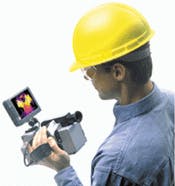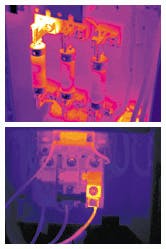IR CAMERAS: New tools increase camera time for thermographers
While acquiring images in the field, modern systems also digitally store analysis functions, text, and voice comments for automatic downloading into computerized reports.
Robert P. Madding, Bernard Lyon, and Mary Fallon
Infrared (IR) predictive-maintenance cameras are used to evaluate the condition of a wide variety of industrial facilities and electrical and mechanical equipment. However, industry estimates suggest that thermographers working on predictive-maintenance applications can spend up to 60% of their time generating reports and only 40% actually using an IR system in the field looking for problems that could shut a plant down. Infrared-camera manufacturers have addressed this problem by developing software platforms and incorporating changes in the cameras themselves.
FIGURE 1. Handheld infrared camera provides images of potential problem areas. Integrated digital voice and text annotation functions allow the user to streamline surveys and accurately record and report details for each stored image.
As a result, modern thermographic systems include a number of features specifically designed to automate the reporting process to the point where a report is nearly done by the time a thermographer working in the field returns to the office. For instance, analysis functions, text, and voice comments can be digitally stored on removable data storage cards with the camera images in the field and then automatically downloaded and embedded into results tables and report text (see Fig. 1).
Windows-based image analysis and reporting software integrated with modern IR cameras makes it possible to create quick reports and make critical decisions about the condition and recommended repair action of the equipment and facilities inspected. Wizard-guided reporting software allows even occasional users to automatically generate both simple and complex multipage reports. Another feature common in many predictive-maintenance software programs is the ability to embed IR images gathered by the inspection cameras directly into Word and Excel files.
The result is a report that automatically combines thermal images with the reference and hot-spot temperature values, camera parametric data such as emissivity, date, time, and location, as well as target identification, name of thermographer, and recommended action.
IR survey background
A typical thermography survey can generate 30 to 100 problem finds ranging from minor to critical (see Fig. 2). Visual images are often included in a report, and image and text data can easily cause reports to be 10 to 20 megabytes in size. How important is archiving all this data so you can retrieve it in an efficient, usable way?
A plant manager at a large electric utility expressed his frustration with the entire process. "I don't want all this paperwork," he said. "In a perfect maintenance world, the electrician would find a problem with his IR camera and fix it on the spot. Then we wouldn't have to spend all this time in the office generating all these reports." However, reports are still needed.
Predictive-maintenance practices protect critical equipment, that is, equipment that cannot be taken off-line without significant impact on production. Infrared thermographers survey this critical equipment under load, but it is unlikely that they could find a problem on heavily loaded critical equipment and fix it on the spot. Spare parts are another issue. Often spare parts are not on hand for immediate repair. In addition, maintenance histories are quite useful for tracking chronic problem components. Fixing a problem on the spot with no paperwork would destroy the maintenance-history process. So, even though we find paperwork frustrating, it plays a crucial role in our predictive-maintenance practices and in optimizing maintenance.
A reasonable goal for a predictive-maintenance program, therefore, is to minimize paperwork while also keeping good records and getting the job done correctly. And to achieve that goal, the IR report should simply show the problem, define clearly when it was found and where it is, and what needs to be done. A complete report can be generated automatically from field data on the thermography setup, the equipment being inspected, and the logistics of the inspection, coupled with the thermographer's recommendations for action.
Tracking IR data
Database software allows us to store IR image and temperature data and tie it to components. Relational databases such as Access are especially good at this. The relational aspect reduces the amount of duplicate data input while giving a great amount of flexibility in searching and filtering. The ability to filter data to a smaller subset is significant for IR predictive-maintenance users as the image files tend to require considerable memory, and there is a large quantity of equipment and components to track. The ability to search on a variety of factors such as component type, number, date, and problem type is also important.
FIGURE 2. Typical of the thermal images gathered during predictive-maintenance inspections with an IR camera are these of a hot A phase fuse (top) and a hot connection on an electrical panel (bottom).
The database can be as simple as an Excel spreadsheet component list with hyperlinks to image data, ot it can be as complex as a custom written package tailored exactly to specific needs. IR camera manufacturers have developed database software to help keep track of IR images. The ultimate choice of one database path or another deserves serious consideration. Future upgrades and ability to link up with other software packages should be key factors in the decision-making process. So it is important to choose database software with open database connectivity (ODBC), which allows compatibility with similar software.
Tracking IR images is the first step in trending, because image trends cannot be identified if the images can't be found. However the tracking function does not automatically generate trends. The data may need massaging to ensure valid comparison among IR images taken at different times.
In summary, advances in both IR camera technology and predictive-maintenance software are helping to automate the report process. Consequently themographers are beginning to reduce the reporting time spent at their computers and to increase the hands-on "camera time" spent using IR technology to find problems and avoid costly downtime in industrial settings.
ROBERT P. MADDING is Infrared Training Center manager, BERNARD LYON is Infrared Training Center thermography course moderator, and MARY FALLON is manager, industrial marketing, at FLIR Systems-Boston, 16 Esquire Rd., North Billerica, MA 01862; www.flir.com.


